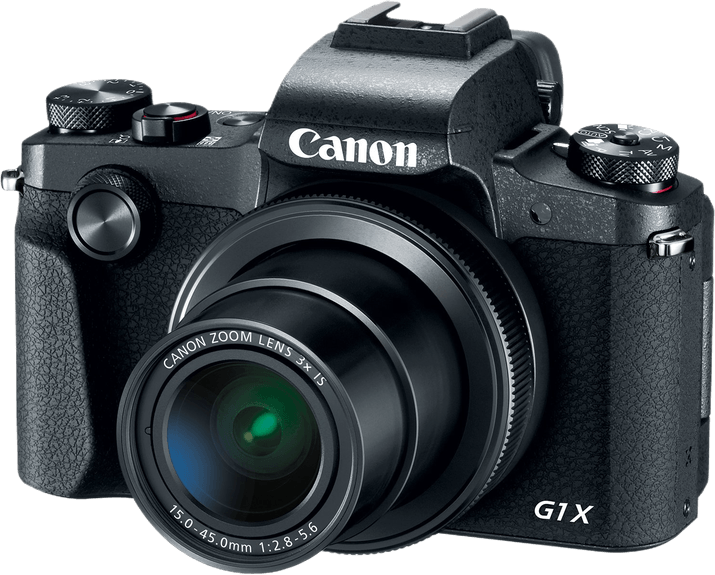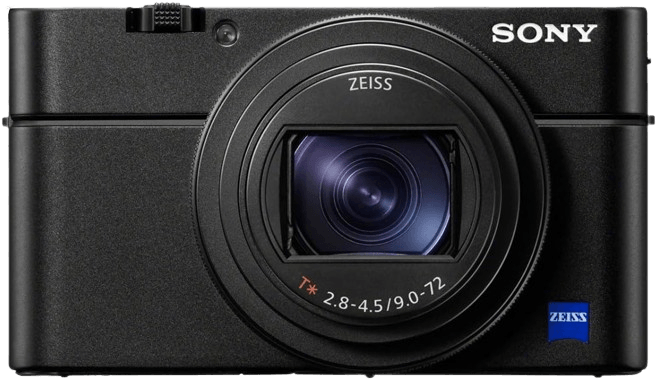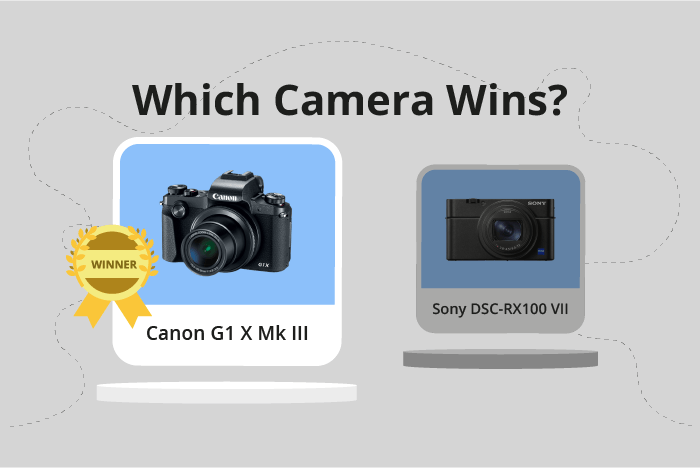Canon PowerShot G1 X Mark III vs Sony Cyber-shot DSC-RX100 VII Comparison
Canon PowerShot G1 X Mark III

Sony RX100 VII

The Canon PowerShot G1 X Mark III narrowly wins with a score of 62/100, while the Sony Cyber-shot DSC-RX100 VII follows closely behind with a score of 60/100. Both cameras share similarities, with the Canon being a bridge camera and the Sony being a compact camera. They were both released in the mid-2010s, with the Canon in 2016 and the Sony in 2019.
The Canon G1 X Mark III has an advantage in size and weight, measuring 138 x 102 x 135mm and weighing 915g, making it more substantial and robust. On the other hand, the Sony RX100 VII is smaller and lighter, measuring 102 x 58 x 43mm and weighing 302g, which makes it more portable and easier to carry around.
Despite the Canon’s higher score, the Sony RX100 VII has a more recent release date and a slightly higher launch price of $1200 compared to the Canon’s $1120. This suggests that the Sony camera may offer more up-to-date features and technology.
Ultimately, the Canon PowerShot G1 X Mark III is the winner due to its higher score, but the Sony Cyber-shot DSC-RX100 VII is a strong competitor with its compact size, lighter weight, and more recent release date.
Canon PowerShot G1 X Mark III vs Sony Cyber-shot DSC-RX100 VII Overview and Optics
The Canon PowerShot G1 X Mark III wins in optics with a score of 63/100, compared to the Sony Cyber-shot DSC-RX100 VII’s score of 61/100. Both cameras share some common specifications, such as having 20 megapixels, a CMOS sensor, a 1″ sensor size, a fixed lens mount, and image stabilization.
The G1 X Mark III outperforms the RX100 VII in several aspects. The shooting speed of the Canon camera is 12, which is more than double the Sony’s shooting speed of 5. This allows the G1 X Mark III to capture fast-moving subjects more effectively. Additionally, the Canon camera has a higher DXOMARK score for its sensor at 71, compared to the RX100 VII’s score of 63. This indicates that the G1 X Mark III has better image quality and low light performance.
On the other hand, the Sony RX100 VII has some advantages over the Canon G1 X Mark III. Its processor, the Bionz X, provides faster processing and better noise reduction than the Canon’s Venus Engine. This can result in smoother and cleaner images, especially in low light situations.
In comparing the two cameras, the Canon PowerShot G1 X Mark III takes the lead in optics due to its superior shooting speed and sensor performance. However, the Sony Cyber-shot DSC-RX100 VII holds its ground with a more advanced processor, contributing to better noise reduction. Both cameras have their strengths and weaknesses, but the Canon G1 X Mark III ultimately comes out on top in the optics category.
Canon PowerShot G1 X Mark III vs Sony Cyber-shot DSC-RX100 VII Video Performance
The Sony Cyber-shot DSC-RX100 VII outperforms the Canon PowerShot G1 X Mark III in video capabilities, scoring 91/100 compared to Canon’s 83/100. Both cameras share certain specs, such as 4K max video resolution and built-in time-lapse functionality. However, the Sony camera excels in specific areas, making it the superior choice for video recording.
One advantage of the Sony RX100 VII is its higher max video frame rate of 120fps, double the Canon G1 X Mark III’s 60fps. This allows for smoother slow-motion footage and better motion capture in fast-paced scenes. Additionally, the Sony camera’s max video dimensions are slightly smaller at 3840 x 2160, compared to the Canon’s 4096 x 2160. This difference may not be significant for most users, but it could be a factor for those seeking the highest possible resolution.
While the Canon G1 X Mark III does not surpass the Sony RX100 VII in video capabilities, it still offers solid performance with 4K resolution and time-lapse functionality. Its slightly larger video dimensions may appeal to some users, but the difference in frame rate is the more critical factor in this comparison.
Considering the higher video score and superior specs, the Sony Cyber-shot DSC-RX100 VII is the better choice for video recording. Its 120fps max frame rate and 4K resolution provide smooth, high-quality footage that exceeds the Canon PowerShot G1 X Mark III’s capabilities. Although the Canon camera has a larger video dimension, its lower frame rate and overall video performance make it the less desirable option for those prioritizing video quality.
Canon PowerShot G1 X Mark III vs Sony Cyber-shot DSC-RX100 VII Features and Benefits
The Canon PowerShot G1 X Mark III takes the lead in features with a score of 70/100, while the Sony Cyber-shot DSC-RX100 VII follows closely with a score of 68/100. Both cameras share a 3-inch touchscreen and flip screen, as well as GPS, WIFI, and Bluetooth capabilities. However, there are differences that set these cameras apart.
The Canon PowerShot G1 X Mark III has a higher screen resolution of 1,040,000 dots, compared to the Sony Cyber-shot DSC-RX100 VII’s 921,000 dots. This difference allows the Canon camera to display sharper and clearer images on its screen, providing a better user experience to photographers.
On the other hand, the Sony Cyber-shot DSC-RX100 VII does not outperform the Canon PowerShot G1 X Mark III in any specific feature mentioned. Both cameras offer similar features in connectivity and screen capabilities, with only the screen resolution favoring the Canon model.
Considering the feature scores and specifications, the Canon PowerShot G1 X Mark III is the better camera in terms of features. Its higher screen resolution provides an advantage over the Sony Cyber-shot DSC-RX100 VII. However, the Sony model remains competitive due to its comparable features in other aspects. Buyers should consider their preferences and needs to determine which camera best suits their requirements.
Canon PowerShot G1 X Mark III vs Sony Cyber-shot DSC-RX100 VII Storage and Battery
The Sony Cyber-shot DSC-RX100 VII outperforms the Canon PowerShot G1 X Mark III in storage and battery with a score of 29/100 compared to Canon’s 21/100. Both cameras have one memory card slot and accept SD/SDHC/SDXC cards. However, the Sony RX100 VII also supports Memory Stick Pro Duo cards, providing more storage options.
The Canon G1 X Mark III has a longer battery life of 350 shots, while the Sony RX100 VII only lasts for 260 shots. Despite this advantage, the Canon lacks USB charging, which the Sony RX100 VII has. This feature allows users to charge the Sony camera more conveniently.
In terms of storage and battery, the Sony RX100 VII offers better storage versatility and USB charging, making it a more practical choice. However, if longer battery life is a priority, the Canon G1 X Mark III may be more suitable. Ultimately, the choice depends on the user’s needs and preferences.
Canon PowerShot G1 X Mark III vs Sony Cyber-shot DSC-RX100 VII – Our Verdict
Are you still undecided about which camera is right for you? Have a look at these popular comparisons that feature the Canon PowerShot G1 X Mark III or the Sony Cyber-shot DSC-RX100 VII:
- Ricoh GR IIIx vs Sony Cyber-shot DSC-RX100 VII
- Canon PowerShot G7 X Mark III vs Sony Cyber-shot DSC-RX100 VII
- Canon PowerShot G5 X Mark II vs Sony Cyber-shot DSC-RX100 VII
- Panasonic Lumix ZS200 (TZ200) vs Sony Cyber-shot DSC-RX100 VII
- Canon EOS R50 vs Sony Cyber-shot DSC-RX100 VII
- Canon PowerShot G1 X Mark III vs PowerShot G7 X Mark III

